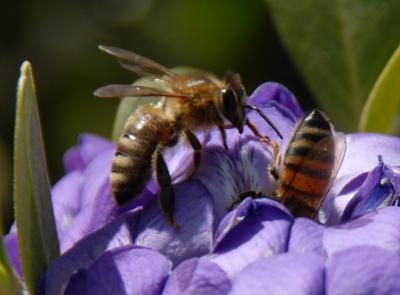Scientists may have figured out how the molecular switch for sex gradually and adaptively evolved in the honeybee. It's been a long journey
The first genetic mechanism for sex determination was proposed in the mid-1800s by the Silesian monk Johann Dzierson, who was trying to understand how males and females were produced in honey bee colonies. He knew that the difference between queen and worker bees – both females – emerged from the different quality and quantity of food. But, what about the males? Dzierson posited that males were haploid – possessing one set of chromosomes, which was confirmed a century later with the advent of high quality microscopes. Under the magnifying lens, researchers could see that eggs that gave rise to drones were not penetrated by sperm. However, how this system of haplodiploid sex determination ultimately evolved at a molecular level has remained one of the most important questions in developmental genetics.
To lay out the final pieces of how these systems evolved, the authors studied 14 natural sequence variants of the complementary sex determining switch (csd gene), for 76 genotypes of honey bees.
The researchers had a big advantage over a monk 200 years ago. Modern biologists know honeybees have one gene locus responsible for sex determination and they also have genetic markers—well-characterized regions of DNA — close to the complementary sex determining locus to allow gene mapping. In addition, the honey bees' high recombination rate — the process by which genetic material is physically mixed during sexual reproduction — is the highest of any known animal studied, which helped them isolate, sequence and characterize the complementary sex determining locus. A decade ago, they were also able to knock out an allele and show how one could get a male from a diploid genotype.

Researchers have uncovered the key to sex determination in honey bees, one of the most important questions in developmental genetics. Credit: Jacob Sahertian
However, the questions of which alleles were key, how they worked together and in what combinations and why this system evolved were left unanswered, though tantalizing close. This compelled the current team of collaborators to step back to review what actually constitutes an allele.
"There has to be some segment of that gene that is responsible in this allelic series, where if you have two different coding sequences in that part of the gene you end up producing a female," said co-author and Arizona State University Provost Robert E. Page Jr. "So we asked how different do two alleles have to be? Can you be off one or two base pairs or does it always have to be the same set of sequences? We came up with a strategy to go in and look at these 18-20 alleles and find out what regions of these genes are responsible among these variants.
"In this process, we also had to determine if there are intermediate kinds of alleles and discover how they might have evolved."
What the authors found was that at least five amino acid differences can control allelic differences to create femaleness through the complementary sex determiner (csd) gene—the control switch.
"We discovered that different amounts of arginine, serine and proline affect protein binding sites on the csd gene, which in turn lead to different conformational states, which then lead to functional changes in the bees—the switch that determines the shift from female to not female," said Page.
The authors also discovered a natural evolutionary intermediate that showed only three amino acid differences spanned the balance between lethality and induced femaleness. These findings—which have taken nearly 200 years of study to pin down—suggested that incomplete penetrance may be the mechanism by which new molecular switches can gradually and adaptively evolve.






Comments